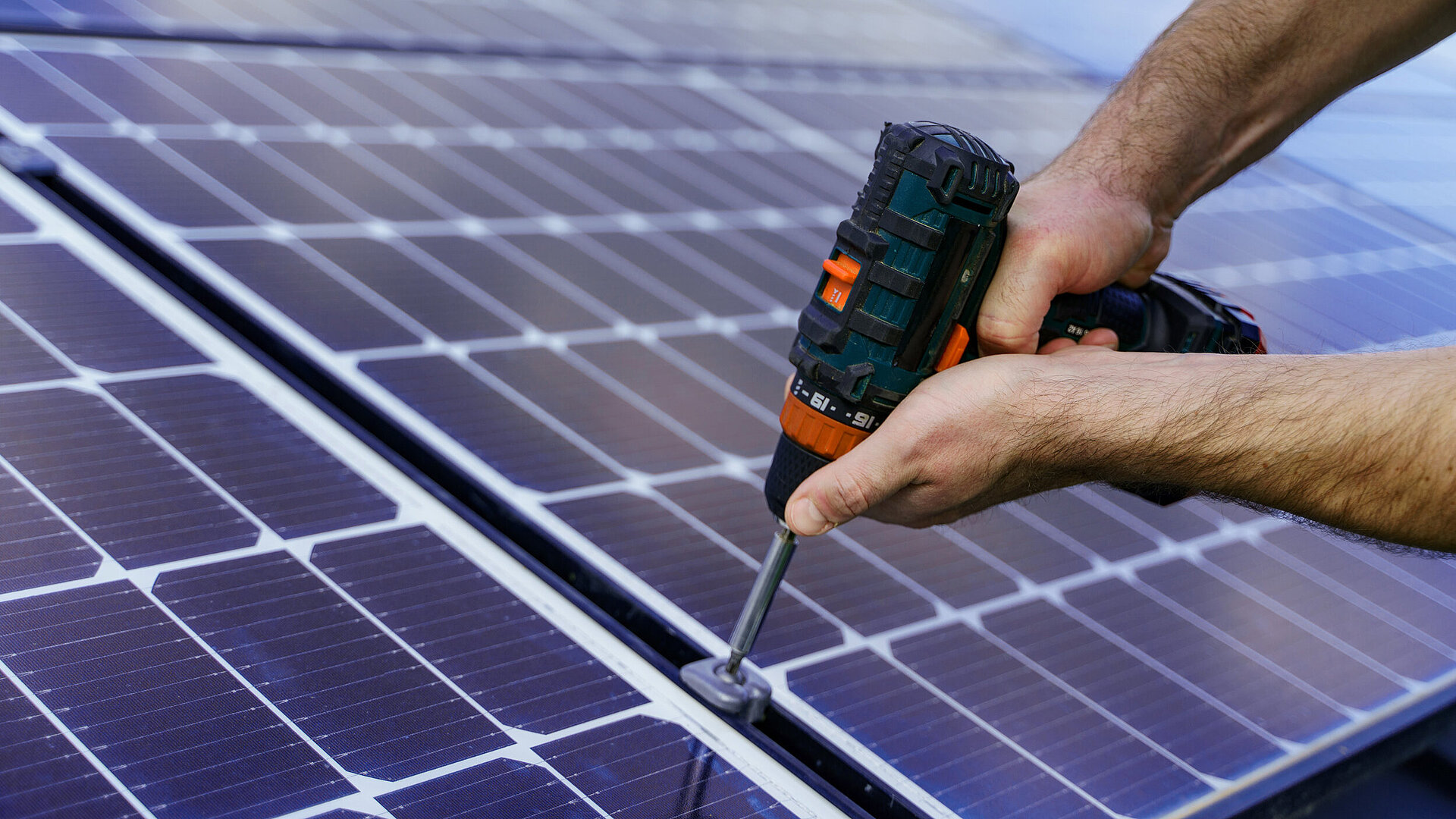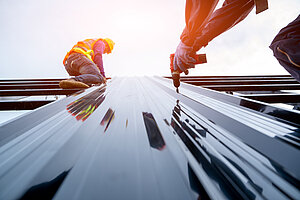The advantages of such a measure are immediately apparent: A sound safety solution on top of the roof will ensure absolute legal certainty in an emergency. The solution will furthermore allow for the risk-free cleaning and servicing of the solar panels, keeping them in peak performance condition and preserving their ability to produce a maximum amount of electricity. Here are a few rules of thumb that will suggest whether such an upgrade is possible or indeed advisable:
- The PV system is exclusively secured by single anchor points – a type of fastening that is expressly advised against in the planning documents issued by the AUVA (Austrian Workers' Compensation Board), the DGUV (German Social Accident Insurance) and the SUVA (Swiss National Accident Insurance Organization).
- But, even scenarios where the placement of the PV panels on the roof does not provide enough room for a fall protection system with class 2 equipment (cable or rail system) will allow for a professional upgrade with, for instance, a BARRIER system made by INNOTECH.
Even after installation is already complete, you as a solar system installer can demonstrate your professionalism and sense of responsibility to your customers by recommending that they expand their PV installation by a certified fall protection system. And, it will be our pleasure to advise and assist you in this regard by sharing our expertise in safety solutions for PV installations on the roof and our extensive portfolio of various safety systems!
Solutions that allow for effortless retrofitting of PV installations on the roof
There is a wide variety of safety solutions that can be fitted on PV installations on the roof. All of them have their pros and cons. The list below will illustrate not only which fall protection systems are available but also the applications for which they can be used:
1. Superimposed load lifeline systems
- VARIO-45: This universal point is installed in a snap and suited perfectly for roof pitch angles of up to 5°. What is more: as it is designed for installation without roof penetration, there is no need to open the roof cladding, preventing the creation of cold bridges.
Use: End, corner and intermediate point in the AIO lifeline system and single anchor point for 1 person (UNI-EAP-10-25).
- QUAD-30-300: This post for green roofs is an excellent choice for green or gravel flat roofs. This system is equally distinguished by its simple installation without roof penetration. Moreover, the QUAD-30-300 is attached / held in place only by the weight of the green roof structure.
Use: Intermediate point in the AIO lifeline system, rail system bracket and single anchor point for 1 person (UNI-EAP-10-25).
The downside of these solutions: They take up a great deal of space and are more costly than other versions.
The advantage: There is no need to open the roof cladding.
2. Installation on metal roofs
- SYST-01: This robust system roof clamp from INNOTECH is exceptionally stable and versatile. Its sliding screw placement allows for optimum adjustment to each specific profile width. Its installation does not require roof penetration and is relatively quick as some elements have been pre-assembled.
Use: End, corner and intermediate point in the AIO lifeline system, rail system bracket and single anchor point for 3 persons (UNI-EAP-10-25).
- SDH-INDUSTRY-31: The robust safety roof hook is ideally suited as a variable support for all crimp heights.
Use: Anchor point and safety roof hook.
- SAND-01: This universal point for trapezoidal sheeting is architecturally unobtrusive and allows for flexible and rapid installation thanks to its universal base plate.
Use: End, corner and intermediate point in the AIO lifeline system, rail system bracket and single anchor point for 3 persons (UNI-EAP-10-25).
3. Installation on PV substructure
- This type of installation integrates the fall protection systems into the PV system and thus takes up no additional space on the roof. The lifeline system AIO and the rail system TAURUS from INNOTECH are installed directly on the PV substructure. Better yet, the installation of the fall protection systems AIO and TAURAS requires no roof penetration and causes no shadowing of the solar panels.

By loading this video, you accept Google's privacy policy.
In which cases is a subsequent installation difficult?
There are, of course, situations or use cases where the subsequent installation of a professional fall protection system is difficult or even impossible. However, it cannot hurt in most cases to evaluate the current safety solution and improve it if necessary. Never forget: When emergency strikes, human lives are at stake – and, in the worst case, claims for damages or pain and suffering or even penalties for the operator on the grounds of gross negligence.
The problem of “lack of space”
There are situations where the PV installation on the room takes up the entire space and leaves only little room for a fall protection system. In that case, it may be necessary to remove some PV modules to secure the roof accordingly. This will, of course, result in a reduction of the surface area available for the solar power plant / the generation of electricity. Notwithstanding, the decision to remove panels may improve efficiency in the medium and long term, as it will allow for the safe performance of servicing and cleaning whenever necessary and, thereby, the maximum output of the panels at all times. These products from INNOTECH are suited perfectly for this type of scenario:
On a flat roof:
- STA-10: Offering extreme stability, this universal post is suitable for nearly all types of substructures and perfect as a end/corner post for the cable and rail systems made by INNOTECH.
- QUAD-11: This post can be used both as a single anchor point and as an intermediate post as part of the AIO lifeline system. It is suitable for every type of substructure.
Another option is to install a guardrail system. The downside is, however, that this system will cast shadows on the modules.
On a pitched roof:
- STA-10 with BEF-203: This fastening set is primarily attached on wood or pitched roofs/wooden rafters such as those found on farms.
- SDH-31: This safety roof hook can be ideally adapted to any conditions on site and requires only modestly dimensioned wood.
Summary
Practice has shown that many existing PV systems on the roof are insufficiently secured against falls. This is why it is always a good idea to revisit and, if necessary, optimise the safety situation even after installation of the systems is complete. Safety can be improved with a wide variety of available and very professional solutions – even in difficult situations. Never forget one thing: The roof ranks among the most dangerous workplaces of all.
And you, as the operator of a PV installation on the roof, are responsible for the safety of all members of the workforce who carry out servicing and cleaning work in that danger area.








![[Translate to Englisch:] [Translate to Englisch:]](https://www.innotech-safety.com/fileadmin/_processed_/1/a/csm_Mehrere_PV-Kunden_gleichzeitig_betreuen__kann_oft_zur_Riesenherausforderung_werden-header_c1a520d846.jpg)
















![[Translate to Englisch:] [Translate to Englisch:]](https://www.innotech-safety.com/fileadmin/_processed_/4/6/csm_Nachtra__gliche_Montage_einer_Absturzsicherung_fu__r_PV-Anlagen_auf_dem_Dach_17da5ff9d7.jpg)




